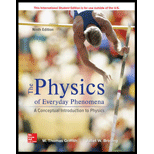
Concept explainers
Whether the leptons are heavier than protons or neutrons and explain the reason.
Answer to Problem 1CQ
The leptons are lighter than the protons and neutrons.
Explanation of Solution
The particles were grouped into three primary groups: leptons, mesons, and baryons. The leptons are the lightest particles and include electrons, positrons, and the neutrinos involved in beta decay.
Neutrons and protons occupy more volume than electron. Electron is a point particle and an elementary particle. Neutrons and the protons are baryons and they both will make some quarks, another quantum, another point particle.
Leptons are mostly lighter particles and they include the almost massless neutrinos, the electron and the muon. The heaviest of this group is the tauon and is almost twice the mass of the proton still.
Conclusion:
Therefore, leptons are the lighter particles than the protons and neutrons.
Want to see more full solutions like this?
Chapter 21 Solutions
Physics of Everyday Phenomena
- Suppose you are designing a proton decay experiment and you can detect 50 percent of the proton decays in a tank of water. (a) How many kilograms of water would you need to see one decay per month, assuming a lifetime of 1031 y? (b) How many cubic meters of water is this? (c) If the actual lifetime is 1033 y, how long would you have to wait on an average to see a single proton decay?arrow_forwardWhich of the following decays cannot occur because die law of conservation of lepton number is violated? (a) np+e (e) e+ve (b) +e++ve(f) e+ve+v (c) +e++ve+v (g) 0+p (d) pn+e++ve (h) K+++varrow_forward(a) Estimate the mass of the luminous matter in the known universe, given there are 1011 galaxies, each containing 1011 stars of average mass 1.5 times that of our Sun. (b) How many protons (the most abundant nuclide) are there in this mates? (c) Estimate the total number of particles in the observable universe by multiplying the answer to (b) by two, since there is an electron for each proton, and then by 109, since there are far more particles (such as photons and neutrinos) in space than in luminous matter.arrow_forward
- (a) What particle has the quark composition u-u-d? (b) What should its decay made be?arrow_forwardA neutron star is a cold, collapsed star with nuclear density. A particular neutron star has a mass twice that of our Sun with a radius of 12.0 km. (a) What would be the weight of a 100-kg astronaut on standing on its surface? (b) What does this tell us about landing on a neutron star?arrow_forward(a) What is the approximate force of gravity on a 70-kg person due to the Andromeda Galaxy, assuming its total mass is 1013 that of our Sun and acts like a single mass 0.613 Mpc away? (b) What is the ratio of this force to the person’s weight? Note that Andromeda is the closest large galaxy.arrow_forward
- The Big Bang that began the universe is estimated to have released 1068 J of energy. How many stars could half this energy create, assuming the average star's mass is 4.001030 kg?arrow_forwardExplain why a bound system should have less mass than its components. Why is this not observed traditionally, say, for a building made of bricks?arrow_forwardThe peak intensity of the CMBR occurs at a wavelength of 1.1 mm. (a) What is the energy in eV at a 1.1mm photon? (b) There are approximately 109 photons for each massive particle in deep space. Calculate the energy of 109 such photons. (c) If the average massive particle in space has a mass half that of a proton, what energy would be created by convening its mass to enemy? (d) Does this imply that space is “matter dominated”? Explain briefly.arrow_forward
- What is the ratio of the strength of the strong nuclear force to that of the electromagnetic force? Based on this ratio, you might expect that the strong force dominates the nucleus, which is true for small nuclei. Large nuclei, however, have sizes greater than the range of the strong nuclear force. At these sizes, the electromagnetic force begins to affect nuclear stability. These facts will be used to explain nuclear fusion and fission later in this text.arrow_forwardWhy couldn’t atomic nuclei exist when the e of the Universe was less than 2 minutes?arrow_forwardThe primary decay mode for the negative pion is +v . (a) What is the energy release in MeV in this decay? (b) Using conservation of momentum, how much energy does each of the decay products receive, given the is at rest when it decays? You may assume the muon antineutrino is massless and has momentum p = E/c , just like a photon.arrow_forward
 Classical Dynamics of Particles and SystemsPhysicsISBN:9780534408961Author:Stephen T. Thornton, Jerry B. MarionPublisher:Cengage Learning
Classical Dynamics of Particles and SystemsPhysicsISBN:9780534408961Author:Stephen T. Thornton, Jerry B. MarionPublisher:Cengage Learning University Physics Volume 3PhysicsISBN:9781938168185Author:William Moebs, Jeff SannyPublisher:OpenStax
University Physics Volume 3PhysicsISBN:9781938168185Author:William Moebs, Jeff SannyPublisher:OpenStax An Introduction to Physical SciencePhysicsISBN:9781305079137Author:James Shipman, Jerry D. Wilson, Charles A. Higgins, Omar TorresPublisher:Cengage Learning
An Introduction to Physical SciencePhysicsISBN:9781305079137Author:James Shipman, Jerry D. Wilson, Charles A. Higgins, Omar TorresPublisher:Cengage Learning Glencoe Physics: Principles and Problems, Student...PhysicsISBN:9780078807213Author:Paul W. ZitzewitzPublisher:Glencoe/McGraw-Hill
Glencoe Physics: Principles and Problems, Student...PhysicsISBN:9780078807213Author:Paul W. ZitzewitzPublisher:Glencoe/McGraw-Hill Horizons: Exploring the Universe (MindTap Course ...PhysicsISBN:9781305960961Author:Michael A. Seeds, Dana BackmanPublisher:Cengage Learning
Horizons: Exploring the Universe (MindTap Course ...PhysicsISBN:9781305960961Author:Michael A. Seeds, Dana BackmanPublisher:Cengage Learning Modern PhysicsPhysicsISBN:9781111794378Author:Raymond A. Serway, Clement J. Moses, Curt A. MoyerPublisher:Cengage Learning
Modern PhysicsPhysicsISBN:9781111794378Author:Raymond A. Serway, Clement J. Moses, Curt A. MoyerPublisher:Cengage Learning





